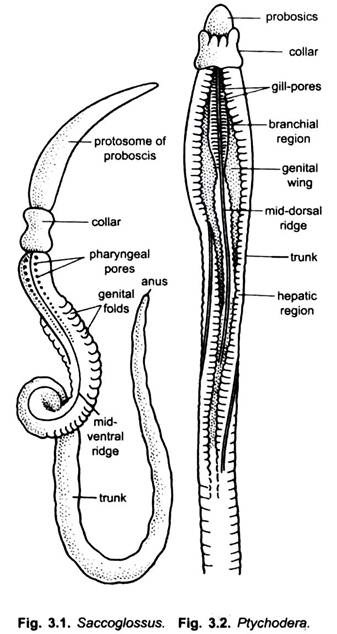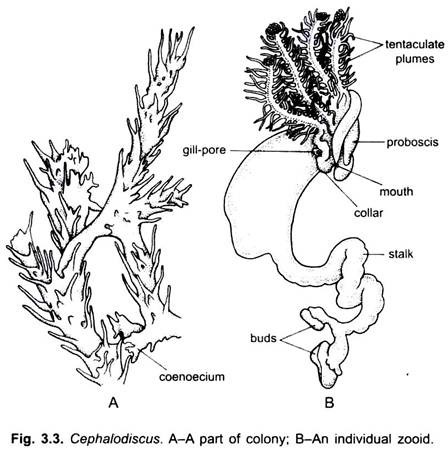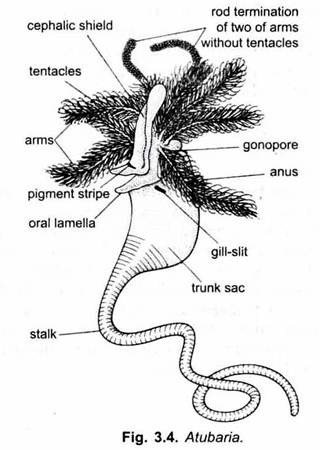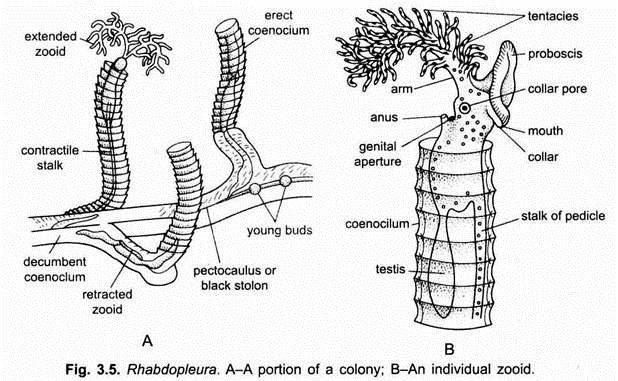The following points highlight the five main representative types of hemichordata. The types are: 1. Saccoglossus (=Dolichoglossus) 2. Ptychodera 3. Cephalodiscus 4. Atubaria 5. Rhabdopleura.
Type # 1. Saccoglossus (=Dolichoglossus):
Saccoglossus (Fig. 3.1) is a typical enteropneust very much similar to Balanoglossus in habits, habitat and structure. It is a marine, slender soft- bodied tongue worm living in spirally twisted furrows. Body is divisible into proboscis, collar and a trunk. Proboscis or protosome is exceptionally elongated and pointed than in other tongue worms. Collar slightly overhangs the beginning of the trunk covering first three or four pairs of gill-pores. Trunk is differentiated into anterior branchial region and posterior branchial region.
Genital wings and hepatic caeca are absent. Alimentary canal is straight and anus lies at the posterior end of the body. Mature gonads are yellow in male and gray in female and their position is marked externally by dorsolateral genital folds in the middle part of the trunk. Synapticula are absent so that tongue bars hang freely in their gill-slits. Sexes are separate and fertilisation is external. Development is direct without a free-swimming tornaria larva. Saccoglossus is found in the Indo- Pacific Atlantic coasts, New Zealand and Australia.
Type # 2. Ptychodera:
Ptychodera (Fig. 3.2) bears a close resemblance to Balanoglossus in habits, habitat and structure. It is soft-bodied, slender marine burrowing animal. The general colour of the animal is yellowish. Its body is elongated and divisible into proboscis, collar and trunk. Proboscis and collar are short, while trunk is quite elongated. Gonads are situated in the genital wings. Hepatic caeca are distinct. Sexes are separate. Development is indirect involving a free-swimming tornaria larva. It exhibits bioluminescence. Ptychodera is found in the sea of tropical and subtropical regions.
Type # 3. Cephalodiscus:
ADVERTISEMENTS:
Cephalodiscus (Fig. 3.3) individuals or zooids occur together in large aggregations attached to objects on the sea bottom in tropical and temperate oceans. The zooids live in separate tubes embedded in a common matrix called a coenoecium but the various zooids are free from each other.
A zooid of Cephalodiscus has a general structure like that of Balanoglossus. The body has a proboscis, collar and trunk borne on a hollow muscular stalk. The proboscis is a ventrally bent disc. The collar bears several hollow branched arms in two rows, they bear tentacles and are spoken of as tentaculated arms, the arms bear cilia which drive a food laden current of water into the mouth.
ADVERTISEMENTS:
The trunk is a plump sac having a U-shaped alimentary canal with a ventral mouth and a dorsal anus. In the anterior part of the trunk is a single pair of gill-clefts. Sexes are separate each has a pair of gonads opening by separate gonopores situated dorsally on the front part of the trunk. Fertilisation and direct development with no larval stage occur in the coenoecium. The original individual is produced sexually, on its trunk is a peduncle bearing buds, the buds become free and each forms a zooid which secretes a tube.
Type # 4. Atubaria:
Atubaria (Fig. 3.4) was first described by Sato in 1936. It is sedentary and solitary genus found attached with hydroid colonies by its long stalk and closely resembling with Cephalodiscus. A coenoecium is absent. The zooid is about 1.5 mm in length. It has three divisions of body. The collar bears four pairs of tentaculated arms of which second pair distally has rod-like terminations devoid of tentacles. Only one pair of pharyngeal gill-slits are present.
Type # 5. Rhabdopleura:
Rhabdopleura (Fig. 3.5) is a true colonial form. The colonies are attached to stones, corals and sessile marine animals mostly in the North Atlantic. The colony has a thin horizontal branching tube called a coenoecium from which short erect tubes arise, each containing a zooid.
ADVERTISEMENTS:
A zooid is minute its general structure is like an enteropneust with a proboscis, collar and trunk, attached to the trunk is a stalk. On the collar is a pair of hollow branching arms having cilia which collect the food of the animal. Alimentary canal is U-shaped so that the anus lies close to the mouth. There are no gill-clefts and a glomerulus is lacking.
Sexes are separate, each sex has a single gonad with a gonopore on the right side. Large yolky eggs are laid. An original individual is produced sexually, on its trunk is a peduncle which bears buds, the buds do not become free and each forms a zooid. Each zooid secretes its own ringed vertical tube or case which is formed ring by ring. The horizontal part of each tube has a black stolon which connects the various zooids to the parent so that a colony of connected zooids is formed.



